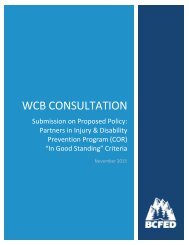KITIMAT DRAFT Report
Create successful ePaper yourself
Turn your PDF publications into a flip-book with our unique Google optimized e-Paper software.
Background<br />
The cost of disability including direct costs such as short-term disability, long-term disability,<br />
total permanent disability and Workers’ Compensation Board (WCB) costs as well as indirect<br />
costs such as lost productivity, overtime pay, temporary help and unhappy customers, continues<br />
to climb for BC organizations. Employers have embraced disability management programs (early<br />
return-to-work programs for example) in response to these rising costs and increased legislative<br />
requirements.<br />
But despite supportive cost data and buy-in from employees/unions and a variety of third parties,<br />
workplace return-to-work programs are experiencing mixed successes. Too often these programs<br />
are too narrow in focus, time limited, inconsistent with human rights legislation and many barriers<br />
to return to work are not properly identified or removed.<br />
Historical Perspective<br />
Foreword<br />
There was a time, not that long ago, when workers injured at work were expected to stay at home<br />
and remain off work until they were completely recovered and able to do the full functions of<br />
their job. That ideology changed in the early to mid eighties and the new mentality gained more<br />
momentum as the courts continued to unravel the meaning of the duties under human rights’<br />
legislation.<br />
There were a number of reasons for the change in attitudes. One reason was the amendment<br />
and enforcement of human rights’ legislation as well as in some jurisdictions, the introduction of<br />
statutory re-employment obligations.<br />
The advancement of a body of medical evidence supporting, that for a majority of musculoskeletal<br />
injuries, the best rehabilitation was aggressive physiotherapy and a reintegration into modified<br />
or transitional duties or transitional work. Physicians were of a consensus that for these types of<br />
injuries, excessive bed rest and passive therapy only served to prolong recovery and lead to the<br />
acceleration of degenerative conditions.<br />
<strong>DRAFT</strong><br />
Perhaps the most significant reason was, although the economy was generally good, employer<br />
costs regarding insurance and workers’ compensation premiums were spiraling through the roof.<br />
Situational assessment<br />
District of Kitimat 1





